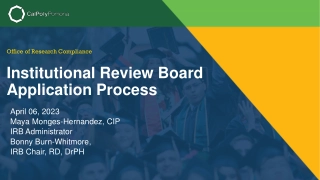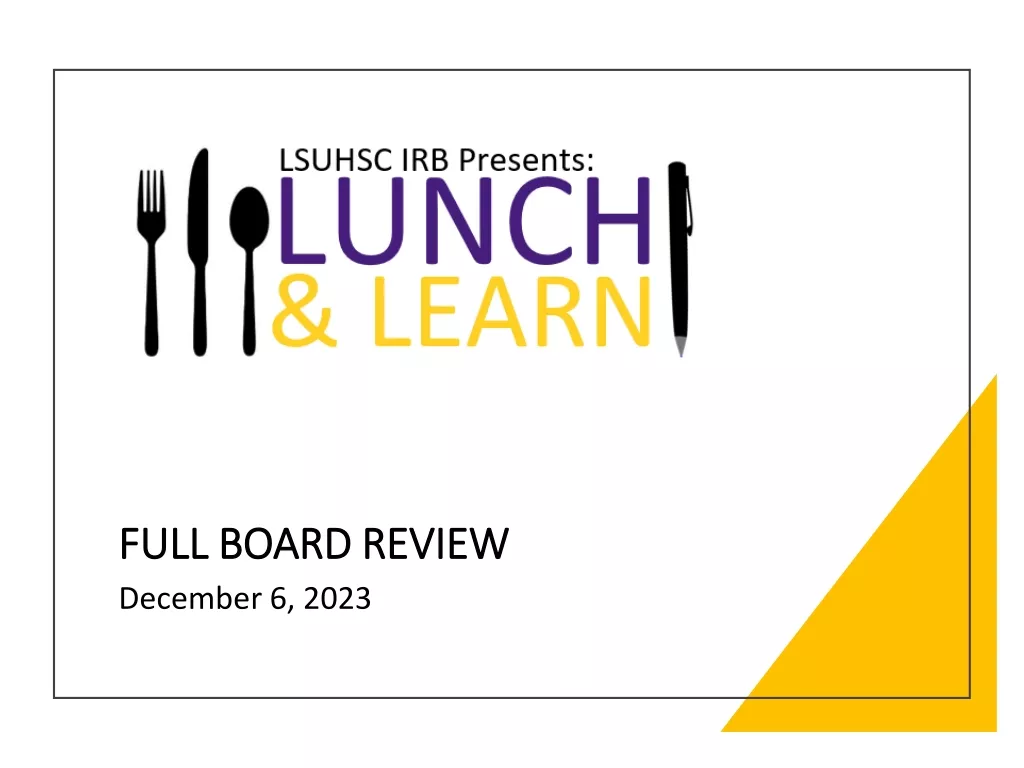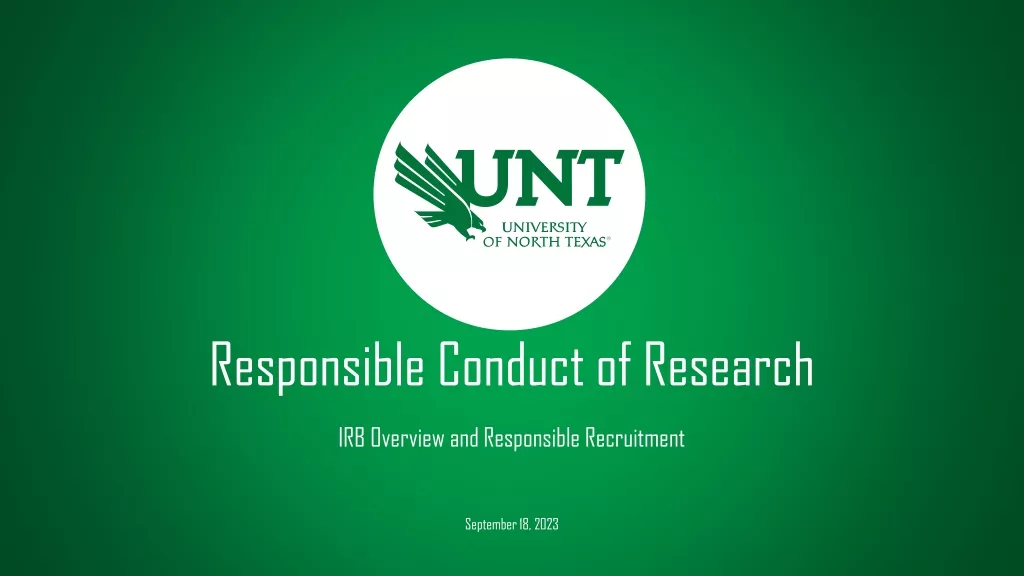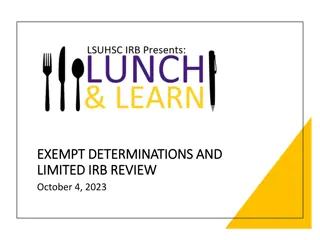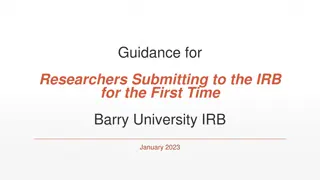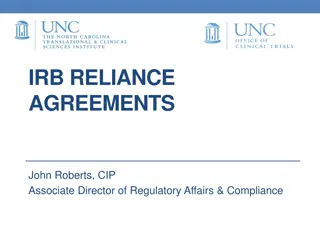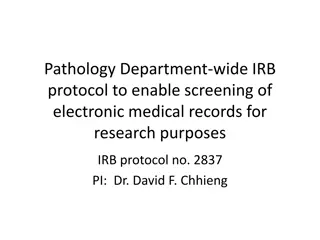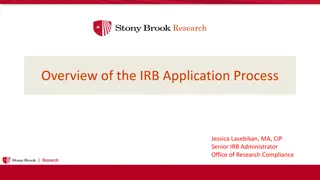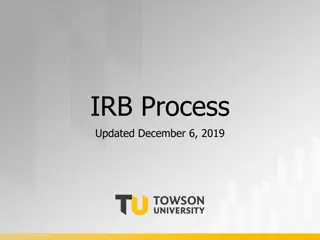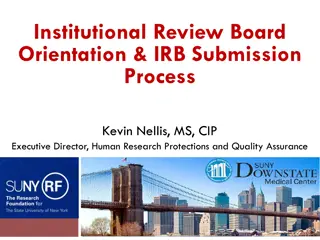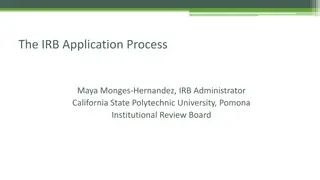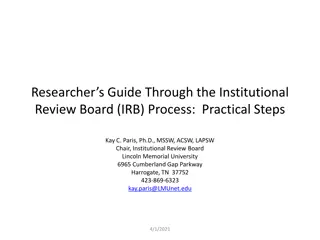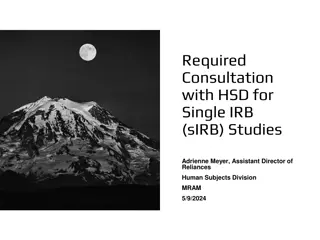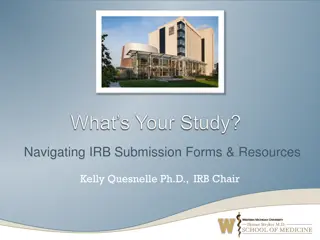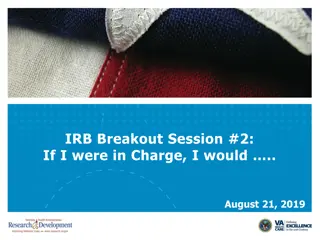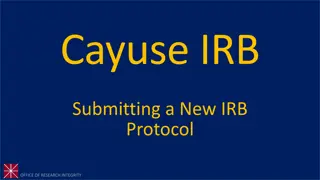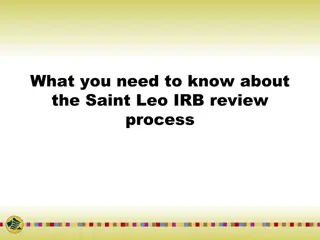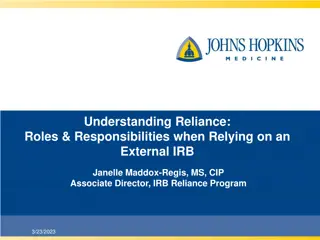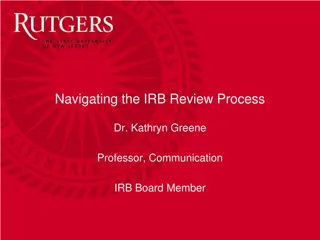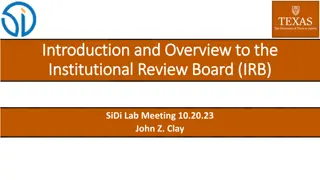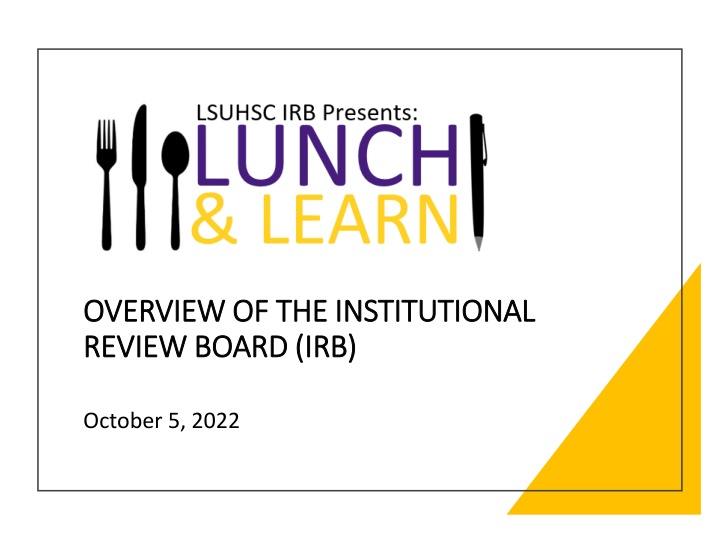
Institutional Review Board (IRB) and Research Regulations
Explore the role of the Institutional Review Board (IRB) in safeguarding research participants' rights and welfare, and learn about the history of IRB regulations, including The Common Rule. Discover the significance of ethical principles in human subject research and the various regulations governing research compliance.
Download Presentation

Please find below an Image/Link to download the presentation.
The content on the website is provided AS IS for your information and personal use only. It may not be sold, licensed, or shared on other websites without obtaining consent from the author. If you encounter any issues during the download, it is possible that the publisher has removed the file from their server.
You are allowed to download the files provided on this website for personal or commercial use, subject to the condition that they are used lawfully. All files are the property of their respective owners.
The content on the website is provided AS IS for your information and personal use only. It may not be sold, licensed, or shared on other websites without obtaining consent from the author.
E N D
Presentation Transcript
OVERVIEW OF THE INSTITUTIONAL OVERVIEW OF THE INSTITUTIONAL REVIEW BOARD (IRB) REVIEW BOARD (IRB) October 5, 2022
Agenda Function of an IRB History of IRB Regulations The Common Rule (45 CFR 46) Important Definitions Review Procedures IRB Review Process & .111 Criteria Tips for Working with the IRB 2
Function of the IRB Integral part of the institution s Human Research Protection Program (HRPP) & responsible for reviewing all HSR studies Role is to ensure participants rights and welfare are adequately protected and the study adheres to sound ethical and scientific principles Provides assurance to the federal government that institution will comply with the applicable rules and regulations 3
History of IRB Regulations National Research Act (1974) Nuremberg Code (1947) Established a commission that produced recommendations regarding review of research by IRBs and resulted in the creation of 45 CFR 46 or The Common Rule (1978) A result of the Nazi Doctors' trial that formed the basis for the Declaration of Helsinki and the Belmont Report HIPAA Privacy Rule (2000) The rule addresses uses and disclosures of private health information for research purpose The Belmont Report (1979) Defined three fundamental ethical principles for human subject research: 1. Respect for Persons 2. Beneficence 3. Justice Declaration of Helsinki (1964) International statement of ethical principles to guide medical professionals conducting research, including guidelines for consent 4
The Common Rule (45 CFR 46) Set of regulations developed to ensure compliance with the principles of the Belmont Report Regulations fall under the Department of Health and Human Services (HHS) There are other regulations that an IRB may comply with dependent upon the type of research: Food and Drug Administration (FDA) Regulations Department of Defense (DoD) Regulations 5
What is Research? A systematic investigation, including research development, testing, and evaluation, designed to develop or contribute to generalizable knowledge. o A systematic investigation is an activity that involves a prospective plan that incorporates data collection, either quantitative or qualitative, and data analysis to answer a question. o Generalizable knowledge is knowledge from which conclusion will be drawn that can be applied to populations outside of the specific study population. 6
What is a Human Subject? A living individual about whom an investigator (whether professional or student) conducting research: i. Obtains information or biospecimens through intervention or interaction with the individual, AND uses, studies, or analyzes the information or biospecimens; or ii. Obtains, uses, studies, analyzes, or generates identifiable private information or identifiable biospecimens 7
What is Minimal Risk? Minimal Risk for the General Public as defined by 45 CFR 46.102(i) The probability and magnitude of harm or discomfort anticipated in the research are not greater than those ordinarily encountered in daily life or during the performance of routine physical or psychological examinations or tests Minimal Risk for Prisoners as defined by 45 CFR 46.303(d) The probability and magnitude of physical or psychological harm is that normally encountered in the daily lives, or in the routine medical, dental, or psychological examination of a healthy person 8
Privacy vs. Confidentiality Privacy A subject's control over the extent, timing, and circumstances of sharing themselves and their information Confidentiality Pertains to the treatment of information that the subject has agreed to disclose for the purpose of research Privacy is about the Person; Confidentiality is about the Data 9
IRB Review Procedures Administrative Review Non-HSR Determinations not subject to IRB review Exempt Determinations less than minimal risk Reliance Requests relying on external IRB Review Expedited Review minimal risk Full Board Review greater than minimal risk 10
IRB Review Process Submission of the Application to the IRB Full Review or Administrative Review Initiation of IRB Application via Kuali If Full Board, Assignment of Board Reviewer If Full Board, Review is Presented at Convened Meeting If Changes Needed, Application Returned to Study Team Designated IRB Member Issues Approval Study May Begin 11
The .111 Criteria for Approval 1. Risks to subjects are minimized 2. Risks are reasonable in relation to anticipated benefits 3. Selection of subjects is equitable 4. Informed consent will be sought from each subject or their LAR 5. Informed consent will be appropriately documented or waived 6. Plan for adequate provisions for monitoring data collection for safety, when appropriate 7. Adequate provisions to protect privacy and maintain confidentiality of the subject, when appropriate 8. Additional safeguards are included when some or all of the subjects are likely to be vulnerable As required by the Common Rule (45 CFR 46.111) and FDA Regulations (21 CFR 56.111) 12
Tips for Successful IRB Submission Make sure training is completed by all members of the study before submission. Feel free to reach out to the staff to verify it is complete Do not ask for a determination of application type over email; it is easier for the staff to make a determination using information provided in the application Permission letters are required for research conducted at many external sites - obtain them in advance Use REDCap for data collection Forms from our website each time to ensure you have the latest version. Place version dates on your documents at initial submission and only change them when updating the document. 13
Tips for Communicating with the IRB Exempt from IRB does not mean you don't have to submit anything to the IRB. Exempt Determination is an IRB review procedure Expedited review does not mean that we will hasten our review. Expedited review is an IRB review procedure Please be kind. We are not here to make your life more difficult; we are here to not only protect human subjects, but we are also protecting you as the researcher and the institution as a research site. Email IRBoffice@lsuhsc.edu with any questions or concerns 14
Resources IRB Website: https://www.lsuhsc.edu/administration/academic/ors/irb/ Consent Templates: https://www.lsuhsc.edu/administration/academic/ors/irb/consent_form_tem plates.aspx HIPAA Authorization Templates: https://www.lsuhsc.edu/administration/academic/ors/irb/hipaa_forms.aspx Training Requirements: https://www.lsuhsc.edu/administration/academic/ors/irb/educational_require ments.aspx Policies & Procedures: https://www.lsuhsc.edu/administration/academic/ors/irb/irb_policies.aspx 16


